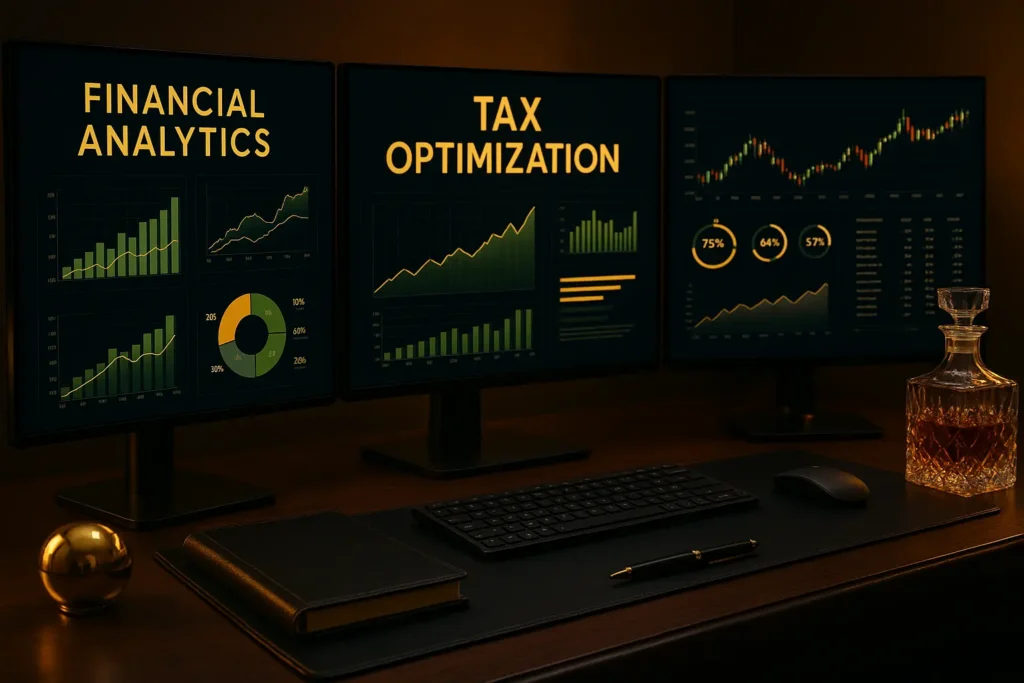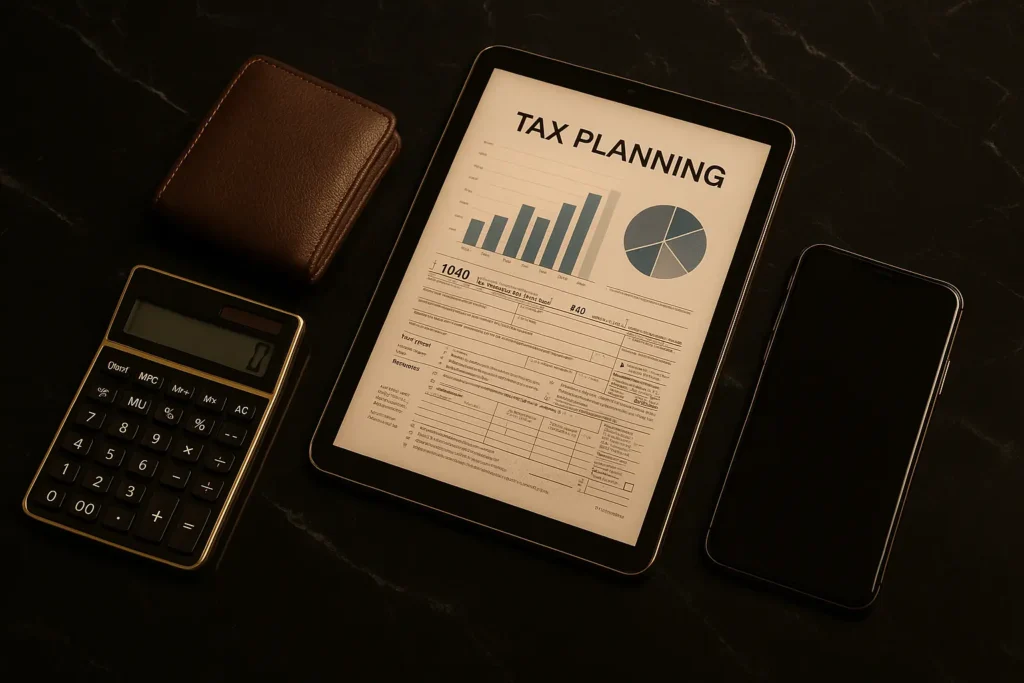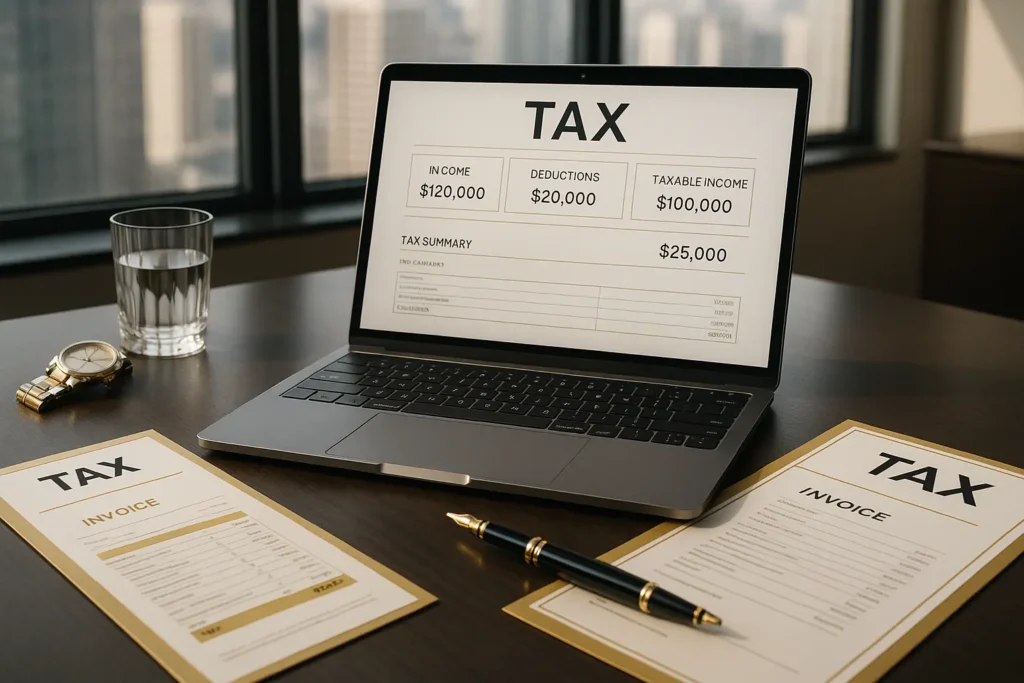Top 10 Tax Tips for Small Business Owners in 2025
Introduction: Why Tax Planning is Critical for Small Business Success
Tax planning isn’t just a once-a-year task – it’s a year-round strategy that can make or break a small business’s bottom line. By staying organized and proactive, small business owners can minimize taxes legally and keep more of their hard-earned income. Good tax planning means keeping thorough records, tracking deductible expenses, and understanding how payments like estimated taxes work. It also means choosing the right business structure and saving for retirement in tax-advantaged ways. In fact, owners who focus on tax planning can avoid cash-flow surprises and penalties.
Maintaining solid accounting habits is the foundation of tax planning. Small business accounting tools and bookkeeping practices help create a clear picture of revenue and costs. When records are complete and well-organized, year-end tax prep becomes far less painful, and your accountant or tax software can easily identify deductions. A 2025 small business tax guide emphasizes that categorizing income, expenses, receipts, and invoices throughout the year “ensures a smoother filing process” and helps “minimize errors and oversights”.
Good tax planning also means staying informed about current tax laws. For example, the IRS recently announced inflation adjustments for 2025, including increases in the standard deduction and tax brackets. Some provisions (like the 20% Qualified Business Income deduction) are set to expire after 2025. By keeping up with these changes, through IRS updates, tax news, or a tax advisor, small business owners can make strategic decisions (such as timing income or maximizing credits) ahead of deadlines.
Finally, remember that tax planning isn’t about paying less than you owe; it’s about paying only what you owe, no more. The goals are to maximize allowable deductions, pay taxes on time to avoid penalties, and leverage any credits or retirement savings that can reduce taxable income. Throughout this article, we’ll cover concrete tips (and common mistakes) to help small businesses and sole proprietors save money on taxes in 2025 while staying fully compliant. For related advice on tools and resources, see our guides “How to Choose Accounting Software” and “Best Business Bank Accounts 2025.

Tip 1: Organize Your Financial Records Year-Round
The single best habit for smooth tax filing is to keep accurate records of all business transactions every month. This means saving receipts, invoices, bank statements, and expense reports in an orderly system (whether digital or paper). The IRS expects you to have documentation for every deduction you claim, so don’t wait until March to sort through a shoebox of receipts. Instead, reconcile your bank and credit-card statements each week, and record transactions in your accounting software.
Use accounting software or cloud bookkeeping tools to categorize income and expenses as they occur. Many modern platforms (like QuickBooks Online, Xero, or FreshBooks) automatically import transactions and let you attach scans/photos of receipts. As QuickBooks notes, “keeping accurate records throughout the year and utilizing tools like accounting software” gives a clearer picture of your finances and tax liability. This approach avoids last-minute scrambles and reduces errors.
Organizing records year-round also helps you spot missing information early. For example, you can flag unpaid invoices, reconcile deposits for credit-card sales (Form 1099-K), and ensure payroll tax payments are current. If you use spreadsheets, maintain a clear chart of accounts (as QuickBooks suggests) and reconcile it to bank statements monthly. If paper is more your style, set up folders or envelopes by month (labeled: “Jan 2025 expenses,” etc.) or by category (“Travel,” “Office supplies,” etc.).
By staying on top of record keeping, you’ll not only simplify business tax preparation each year but also be ready in case of an audit. As one CPA warns, mixing personal and business expenses or lacking documentation can lead the IRS to disallow deductions. In short, organized records are the first line of defense against mistakes and missed deductions.
Tip 2: Know Which Business Expenses Are Deductible
The U.S. tax code allows businesses to deduct “ordinary and necessary” expenses – in other words, legitimate costs of running the business. Common deductible categories for small businesses include:
- Home office expenses: If you have a dedicated workspace in your home (see Tip #5), you can deduct a portion of rent, mortgage interest, utilities, insurance, and maintenance. The IRS offers a simplified safe-harbor method (up to $5/sq. ft. of office space, max $1,500) or an actual-expense method.
- Office supplies and equipment: Items like pens, paper, printer ink, software subscriptions, and small equipment (laptops, phones) are fully deductible. Keep receipts for supplies; these costs add up.
- Business insurance: Premiums for liability insurance, professional errors & omissions, business property insurance, or even cyber insurance can usually be written off.
- Rent and utilities: If you rent office space, workshop, or storefront, the rent is deductible. Similarly, utilities for business premises (electricity, water, Internet, phone lines used for business) are deductible. Even a portion of your home utilities may be deductible under the home office rules.
- Travel and vehicle expenses: When you travel for business (airfare, hotels, rental cars), those costs can be deducted. If you drive your own car for business, you can deduct either actual vehicle expenses or use the IRS mileage rate (67 cents/mile for 2023, to be updated for 2024). Remember: commuting miles (home to office) are not deductible, but trips to meet clients or go to the bank are.
- Meals: Generally, you can deduct 50% of qualifying business meal costs (e.g. lunch with a client). (The rules for meals have varied post-pandemic, so check current IRS guidance.)
- Employee wages and contractor fees: Money paid to employees (wages, payroll taxes, benefits) and to independent contractors (1099 contractors) is deductible. Note: Employee salaries are an expense, but owners of pass-through entities also pay self-employment tax on their share of profit.
- Professional and legal services: Fees for accountants, attorneys, and consultants that are business-related are deductible. This includes tax preparation fees, bookkeeping services, and any business coaching or advisory fees.
- Marketing and advertising: Costs for marketing your business (website costs, advertising, social media marketing, promotional materials) are deductible as ordinary business expenses.
These are just examples. An insurer’s summary notes dozens of possible deductions, and IRS Publication 535 covers them exhaustively. The key is to document every expense carefully. Keep receipts, invoices, or digital records for each deduction. As one finance blog puts it, “tracking [deductions] as you go and summarizing them at year-end” prevents costly omissions.
Finally, watch out for phaseouts or limits. For example, the popular 20% pass-through deduction (for many sole proprietors, partnerships, S corps) is scheduled to expire after 2025. Always check the IRS or consult a tax professional if an unusual expense category (like R&D, green energy credits, or COGS) applies to your business. By maximizing all legitimate deductions, you lower your taxable income and keep more profit in your pocket. For quick reference, see our list of deductible business expenses under Tip 2 in our tax tips for small businesses.

Tip 3: Pay Your Quarterly Estimated Taxes on Time
Unlike employees who have tax withheld, self-employed small business owners must generally pay taxes on income as it is earned. The IRS requires estimated tax payments quarterly to cover income and self-employment taxes. Missing these deadlines can trigger penalties. For 2025, individuals making estimated tax payments should mark these key dates: April 15 (for income earned in Q1: January–March), June 17 (Q2), September 15 (Q3), and January 15, 2026 (Q4). The IRS continues to stress the importance of staying on schedule, especially with the first payment due April 15, as part of the ongoing pay-as-you-earn tax structure.
Filing an extension to submit your return does not extend the payment date. A common mistake is assuming a filing extension means you can pay later, but interest and penalties still accrue from the original due date. Avoid unexpected tax penalties by projecting your full-year tax liability and dividing it into four timely installments. If your earnings shift throughout the year, adjust your estimates accordingly. IRS Form 1040-ES can help you calculate accurately, and payments can be made easily through the IRS Online Account or EFTPS. Set digital alerts so quarterly deadlines don’t slip through the cracks.
Remember, quarterly payments should include not just business profit, but all taxable income (side gigs, investment gains, etc.). Underpaying estimated taxes is a very common trap – one blogger warns small business owners to “set aside a certain amount of revenue and make quarterly payments by specific dates”. Falling behind can result in both failure-to-pay and late-payment penalties. On the flip side, overpaying means a bigger refund.
To simplify estimated taxes, consider using accounting software (many have tax modules) or hire a tax pro. Set up automatic calendar reminders or alerts in your accounting system. QuickBooks advises using “automatic reminders for estimated tax payments and important filing deadlines to avoid penalties”. By staying ahead of deadlines, you avoid surprises and make tax season smoother. (See also Tip #9 on staying informed about any changes to payment rules.)
Tip 4: Choose the Right Tax Structure for Your Business
Your legal business entity (sole proprietor, partnership, LLC, S corp, C corp, etc.) fundamentally affects how you pay taxes. This decision determines which tax forms you file and what rates or self-employment taxes apply. For example, a sole proprietorship is easy to set up, but all profits flow through to your personal return and are subject to the 15.3% self-employment tax. An LLC offers liability protection and pass-through taxation by default, but members still owe self-employment taxes on business earnings.
An S corporation can be advantageous tax-wise: owners can split income into a “reasonable” salary (subject to payroll taxes) and distributions (not subject to self-employment tax). For example, TurboTax notes that organizing as an S-corp “can help you avoid higher self-employment taxes by classifying some income as salary and some as a distribution”. The catch is stricter IRS rules (you must pay yourself a reasonable wage, and file payroll taxes).
A C corporation pays its own corporate tax, but distributions (dividends) are taxed again at the shareholder level, so many small owners shy away due to double taxation. Nonprofit, benefit, or other exotic structures have their own considerations. The U.S. Small Business Administration emphasizes that choosing your entity carefully is critical – it often helps to consult business counselors and accountants before deciding. The wrong choice can mean paying more tax or less liability protection than necessary.
QuickBooks points out that each business entity type comes with its own pros and cons. Sole proprietors and single-member LLC owners declare their earnings on Schedule C and pay self-employment taxes. Partnerships and multi-member LLCs submit Form 1065, passing income directly to partners, who are then responsible for taxes on their portion, including self-employment tax on business profits. S corporations, which use Form 1120-S, allow earnings to flow through to shareholders, potentially lowering self-employment tax burdens, but they must maintain payroll. C corporations, filing Form 1120, are subject to a fixed corporate tax rate on their earnings.
In practice, many new owners start as sole proprietors for simplicity, but if profits grow, converting to an LLC or electing S-corp status might lower taxes. For any business owner, it’s wise to review your structure annually – as QuickBooks advises, “consult a tax professional or legal advisor” to ensure you’re in the most tax-efficient structure.
Tip 5: Maximize the Home Office Deduction
When your business is based at home, you may be able to reduce your tax liability through the home office deduction. This requires setting aside a clearly defined space in your residence that you use solely and frequently for work, like a private office, studio, or workshop that isn’t used for everyday living. Also, your home needs to be your primary business location or a place where clients visit regularly.
Once you qualify, you have two methods: the simplified method or the regular (actual expenses) method. Under IRS safe-harbor rules, you can simply take $5 per square foot of office space, up to 300 sq. ft. (a maximum $1,500 deduction). This method is easy and requires only reporting office sq. footage on Schedule C. Alternatively, you can calculate actual expenses: allocate a percentage of your home’s costs (mortgage interest or rent, real estate taxes, homeowners’ insurance, utilities, and repairs) to the business portion of the home.
For example, if your home office is 10% of your home’s area, you could deduct 10% of those qualifying expenses. Note that some home expenses (like mortgage interest and taxes) are still fully deductible on Schedule A if you itemize, so you deduct only the business portion of them on Schedule C.
To maximize this deduction, keep good records: measure your office space, document direct expenses (like painting or repairs in the office), and track utility bills. If you use the simplified method, be sure your office space does not exceed 300 sq. ft., and note the area each year. If you have a dedicated business storage room or day-care space, the rules differ slightly (see IRS Pub. 587).
Finally, remember that the home office deduction is only for self-employed individuals and partners. Employees cannot claim it (it was eliminated for W-2 employees after 2017). If you do qualify, though, this deduction can significantly lower your taxable income by accounting for a portion of home costs.

Tip 6: Invest in Reliable Tax Software or Cloud Accounting
Modern tax and accounting software can be a game-changer for small business owners. Good cloud-based tools automatically organize transactions, generate reports, and often flag deductions. For instance, QuickBooks Online or Xero can connect to your bank accounts, categorize expenses in real time, and help you generate profit/loss statements at the click of a button. As one review notes, online accounting “automates most of the tedious, error-prone aspects of regulatory reporting,” ensuring tax compliance.
Cloud accounting offers real-time visibility into your finances. You can see up-to-date cash flow and have current data for tax planning. Automated features like up-to-date tax rate calculations, standardized compliance reports, and audit trails mean you’re less likely to miss something. For example, Xero and QuickBooks can generate end-of-year tax reports that summarize your income and deductible expenses, ready for your tax form.
Consider also specialized tax software for business returns. Programs like QuickBooks’ TurboTax Business, H&R Block, or TaxSlayer can guide you through the complex forms for corporations, partnerships, or Schedule C. These tools often incorporate the latest tax law changes and question you about credits/deductions you might otherwise miss. According to Investopedia’s business tax software roundup, these products cover a variety of entity types and offer “many avenues for assistance” to ensure every applicable deduction is found.
Ultimately, using reliable software means fewer manual errors and faster preparation. QuickBooks emphasizes that with good accounting software, “owners can have a clearer picture of their tax liability come tax time”. If budgets allow, look for software with robust support or even integrated bookkeeping/tax services. You may also find value in cloud tools that integrate with payroll (to handle withholding) or time-tracking (for contractor payments). In short, investing in the right tax/accounting tools today will pay off in saved time and stress when filings are due.
(For guidance on choosing software, see our related post “How to Choose Accounting Software.” )
Tip 7: Hire a Qualified Tax Advisor Who Understands Entrepreneurs
Even the best DIY system can miss pitfalls. A specialized tax professional (CPA, Enrolled Agent, or tax attorney) can be invaluable, especially as your business grows. A good tax advisor does much more than crunch numbers at year-end. They can review your business structure, suggest tax strategies, and keep you updated on new laws. As one financial advisory article notes, a tax advisor “works with you to reduce your taxable income and maximize your deductions,” ensuring you don’t overpay Uncle Sam.
QuickBooks echoes this: the tax code is constantly evolving, and a professional can help “navigate these complexities and ensure returns are accurate and compliant”. For example, if you’re unsure about how to handle a new credit (like R&D or energy credits) or the nuances of home office rules, a knowledgeable CPA can provide clarity. They can also help you file things like payroll tax returns or IRS forms (1099s, Form 941) correctly, avoiding penalties.
Engaging with a tax advisor continuously over the year can strengthen your financial planning efforts. Bench Accounting emphasizes that these specialists keep business owners up to date on evolving tax regulations that might affect their ventures. Their insightful guidance could involve suggesting different retirement plan options, identifying deductions you may have missed, or advising on managing cash flow to cover tax responsibilities. Should an audit occur, they are also equipped to represent you and handle the process.
When selecting a tax advisor, seek out professionals experienced with small business owners or entrepreneurs. Make sure they have insight into your specific industry and verify their credentials, such as CPA certification or Enrolled Agent status, along with a proven history of results. Advisory fees often qualify as deductible business expenses, turning the cost into a smart financial move. Engaging an expert not only helps you avoid costly pitfalls but also supports proactive planning, typically delivering savings that outweigh the investment and providing reassurance throughout the process.
Tip 8: Separate Personal and Business Finances
Mixing personal and business funds is one of the biggest bookkeeping mistakes entrepreneurs make. Think of your business as its own financial universe—give it dedicated bank accounts and credit cards to match. Keeping business and personal transactions separate isn’t just smart bookkeeping; it’s a safeguard that simplifies tax deductions and helps you steer clear of audit trouble. Only run business expenses like rent, utilities, supplies, and income through your business account, and leave personal spending in your private account where it belongs.
Why is this so important? If the IRS finds that personal expenses ran through your business accounts, they may disallow related deductions. In QuickBooks’ words, “when personal and business expenses are combined, it becomes challenging to track your business’s financial health and file your taxes accurately”. Mixing funds also blurs how much money the business is actually making. By contrast, a dedicated business account gives a clear audit trail. It also helps build business credit and qualifies you for better banking products (e.g. higher credit limits, business lines of credit).
In practice, open a business checking account in your company’s name (for example, a sole proprietor might use “John Doe DBA MyFreelanceCo”). Get a business credit or debit card for company purchases. If you occasionally put personal money into the business (to cover cash flow), treat that as an owner injection or loan – don’t call it a business expense.
You may find banks now offering small business accounts tailored for entrepreneurs. (See our guide “Best Business Bank Accounts 2025” for recommendations.) The key is consistency: pay all business bills from business accounts and record any owner draws separately. This discipline eliminates confusion when tax time comes and ensures you only deduct true business costs.

Tip 9: Stay Informed on Tax Law Changes in 2025
Tax laws and limits change frequently, so make it a habit to stay updated each year. For 2025, for instance, the IRS announced several inflation adjustments – notably, the standard deduction rose to $15,000 for singles and $30,000 for joint filers. Brackets, credits (like the Earned Income Tax Credit), and retirement plan limits were also updated. Knowing these adjustments helps you plan contributions (e.g., to max out retirement accounts before limits reset) and estimate your liability accurately.
Beyond inflation tweaks, watch for expiring or new tax breaks. As mentioned, the 20% Qualified Business Income (QBI) deduction is set to sunset after 2025, so entrepreneurs relying on it should factor that into future planning. Legislators are also debating changes, such as extending Tax Cuts and Jobs Act provisions or altering payroll tax rules. While some proposals may not become law, it’s smart to follow trustworthy sources (IRS.gov news releases, major accounting firm alerts, or your tax pro’s updates).
Subscribing to IRS newsletters or small business updates is an easy step. Also, many accounting and tax software providers update their guides annually (see IRS Publication 535 and 334, for example). QuickBooks’ own “Entrepreneurship in 2025” report highlights that almost half of owners are worried about missed changes. Staying informed means you can adjust tax strategies (like timing income/expenses or choosing a different retirement plan) in time.
In short, allocate a bit of time each quarter to “tax news”: check IRS announcements, reputable tax blogs, or ask your advisor about any news that affects small businesses. An informed business owner can take advantage of new incentives (like clean energy credits) and avoid surprises (like the gradual rollback of personal exemptions in 2026 if not extended). As conditions evolve, the proactive business will adapt – that’s what keeps you ahead of the curve and out of trouble come filing day.
Tip 10: Plan for Retirement and Use Tax-Advantaged Accounts
Saving for retirement isn’t just wise for your future – it’s a tax strategy today. Contributions to qualified retirement plans reduce your current taxable income. For independent workers, retirement options like a SEP-IRA or Solo 401(k) provide flexible ways to save. With a SEP-IRA, you can allocate up to 25% of your self-employment profits, whereas a Solo 401(k) allows contributions from both your employee and employer roles, all subject to IRS caps. As QuickBooks emphasizes, these contributions are generally tax-deductible, helping to lower the amount of income subject to taxes.
Which plan is best? It depends on your income and whether you have employees:
- SEP IRA: Setting up a SEP IRA is quick and uncomplicated, offering the opportunity to contribute as much as 25% of your earnings, up to nearly $66,000 in 2023. This makes it a smart option for sole proprietors and small businesses looking for a straightforward method to boost their retirement funds.
- Solo 401(k): For a business owner with no employees (except a spouse). You can defer up to $22,500 (2023 limit) as an “employee”, plus ~25% of pay as “employer” (total ~61k+), and make catch-up contributions if over 50. This maximizes yearly savings.
- SIMPLE IRA: SIMPLE IRA: Perfect for businesses with a staff size capped at 100 employees. Contribution limits are more modest compared to a SEP IRA, allowing employee deferrals up to roughly $16,000 in 2024, but it includes employer matching contributions. This plan is easy to manage, making it a practical choice for smaller organizations.
- Defined Benefit/Pension: Rare for tiny businesses, but if you want to sock away a massive tax break (e.g., hundreds of thousands a year), a defined benefit plan can allow that. However, it requires actuarial calculations and admin.
Additionally, remember that self-employed individuals can also deduct health insurance premiums and certain medical HSAs, which are tax-advantaged if you qualify. By maxing out retirement plan contributions, you lower your business’s taxable profit (saving income tax) and simultaneously build retirement savings. QuickBooks highlights that small business owners can often deduct plan contributions if the plan is set up for the business.
It’s wise to consult a financial planner or CPA when choosing a plan because contribution calculations for self-employed income can be tricky. But in every case, retirement plans are one of the most powerful ways entrepreneurs legally cut their taxes while securing their future. Even contributing the maximum to a SEP or Solo 401(k) can save thousands in taxes each year.

Bonus Tip: Common Tax Mistakes Small Business Owners Should Avoid
- Missing Deadlines: Filing late or forgetting payment deadlines is costly. File by April 15 (or the correct due date for your entity), and remember extensions don’t extend payment dates. Set reminders for both returns and estimated tax due dates.
- Underpaying Estimated Taxes: Procrastinating on quarterly payments leads to penalties. As Lili Bank warns, “a common mistake is underpaying estimated taxes”. Avoid surprises by covering your projected tax liability as income arrives.
- Not Paying Payroll Taxes Correctly: If you have employees, ensure you withhold and deposit payroll taxes on time. Missing employer tax deposits can mean penalties, so use payroll services or software to automate this.
- Overlooking Deductions: Many expenses get missed simply because they weren’t tracked. Keep receipts and review potential deductions monthly. One guide notes the mistake of “letting deductions slip through the cracks”. Automating expense tracking (with tax category labels) can help capture all deductible costs.
- Mixing Personal and Business Expenses: We covered this already – commingling accounts will muddy your books. Don’t expense personal coffees or Uber rides on the business card – it may invalidate deductions.
- Misclassifying Workers: Mislabeling workers by classifying employees as contractors, or contractors as employees, can lead to substantial IRS penalties. To prevent this, carefully review the classification guidelines or use the IRS’s 20-factor analysis for accurate determination. The IRS enforces strict consequences if misclassification is uncovered in an audit.
- Ignoring State or Local Taxes: Remember state income tax (if applicable), sales tax, or local business taxes. Just because you filed federal doesn’t mean you’re done. Check your state’s tax deadlines and rules.
- Skipping Professional Help When Needed: Filing simple returns yourself is fine, but complex situations (like multi-state income or large asset purchases) often warrant professional advice. Don’t shy from expert help if uncertainty looms.
Avoiding these mistakes helps ensure that your careful tax planning doesn’t go awry. As one small business blog concludes, “understanding how to avoid common pitfalls” like missed deductions or late payments is the key to staying compliant and keeping more of your earnings.
Conclusion: Build a Tax-Savvy Business for 2025 and Beyond
Tax season can be overwhelming, but by following these tips, small business owners can turn compliance into an advantage. Start by keeping your financial records neat and organized so that filing time is simple. Know your deductible expenses and claim every one properly. Pay taxes on time – quarterly if you must – and use reliable software or a trusted advisor to guide you. Choose a legal structure that fits your long-term goals, and leverage retirement plans and home-office rules to minimize taxes today.
The bottom line: proactive planning saves money. By following these ten tips and staying alert to tax law changes, you can legally reduce your tax bill and avoid penalties. Remember, every dollar saved in taxes is a dollar reinvested in your business. Keep learning and adapting – after all, tax strategy is an ongoing process. Start 2025 with a plan, and you’ll enter future tax years more confident and financially secure.




It’s really a nice and useful piece of info. I am happy that you simply shared this helpful info with us. Please stay us informed like this. Thank you for sharing.